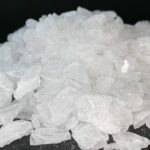How Long Does Methamphetamine Stay In Your System?

Methamphetamine—known as “meth”— is a powerful, highly addictive stimulant that affects the central nervous system. It takes the form of a white, odorless, bitter-tasting crystalline powder that easily dissolves in water or alcohol.
Sometimes it’s made into a white pill or a shiny, white, or clear rock called crystal. Meth is made in the United States and often in Mexico—in “superlabs”—big, illegal laboratories that make the drug in large quantities. But it is also made in small labs using cheap, over-the-counter ingredients such as pseudoephedrine, which is a common ingredient in cold medicines.
It increases the levels of naturally occurring dopamine and norepinephrine in the brain. The effect lasts longer than with cocaine, it is cheaper, and it is easy to make with commonly available ingredients. Street names for this drug include chalk, crank, ice, crystal, and speed.
Discovered in the late 19th century, amphetamine was first used as a nasal decongestant and a respiratory stimulator. During World War 2, methamphetamine — similar in structure to amphetamine — was used to keep military personnel alert and to improve endurance and mood.
In time, it became clear that methamphetamine was dangerously addictive. In the 1970s, the drug was added to the Schedule II list of controlled substances. Methamphetamine is illegal, except when it is prescribed by a physician for a very limited number of medical conditions.
Methamphetamine is easy to produce and it is a potent drug, so it remains a serious drug of abuse. Long-term use is associated with devastating effects on the user and society.
How meth is used and how quickly it works
Methamphetamine can be swallowed, snorted, smoked, or injected. Ice is usually smoked or injected. Depending on how methamphetamines are taken, the effects may be felt immediately (through injecting or smoking) or within 30 minutes (snorting) and approximately 20-30 minutes if swallowed. Overall effects typically last 4-8 hours; residual effects can last up to 12 hours.
How long does meth stay in your system?
There are several factors that come into play when estimating how long Meth will stay in your system because every patient has physiology unique to them. Here are some major factors you should consider when trying to understand how long Meth will stay in your body:
• Age: Typically, the younger you are, the more efficient your body functions are. The more efficient your body functions, the faster Meth will be removed from your system.
• Amount: The higher the dose of Meth you have been taking, the longer Meth will take to be removed from your system.
• Genetics: Genes predispose people to different metabolic functions, which is a key factor in how your body processes medications like Meth. For this reason, your genetic makeup comes into play when estimating how long Meth will remain in your system.
• Kidney and liver functions: The liver and kidneys eliminate everything you ingest, and Meth is no exception. If your liver or kidneys are damaged, it will most likely take longer for your body to remove the Meth from your system.
• Metabolism: Your metabolism determines how quickly you process foods, liquids, and medications such as Meth. If your metabolism is slow, it will take longer for your body to process and eliminate Meth from its system than someone with a fast metabolism.
• Usage frequency: The longer you have been taking Meth, the longer it will remain in your system. For example, it will take longer for someone who has taken Meth for several years to remove Meth from the body than someone who has only been taking Meth for a few months.
Meth is rapidly absorbed after oral ingestion. Peak plasma levels occur within 1 to 3 hours, varying with the degree of physical activity and the amount of food in the stomach. Absorption is usually complete by 4 to 6 hours.
Orally administered Methamphetamine has a mean elimination half-life of 10.1 hours (range 6.4-15 hours). Following intravenous injection, the mean elimination half-life of meth is slightly longer (12.2 hours). Meaning that only half of the drug has been eliminated in the body after this period.
About 94 to 97% of a drug will have been eliminated after 4 to 5 half-lives. Thus, it follows that after 4 to 5 half-lives, the plasma concentrations of a given drug will be below a clinically relevant concentration and thus will be considered eliminated.
This means that orally administered meth including Desoxyn, the pharmaceutical form of methamphetamine will clear out of a person’s system within 2 days (50 hours) while intravenously injected meth will clear out of a person’s system within 2.5 days (60 hours) after the last use but the elimination may vary based on multiple factors already stated above.
How to flush out meth fast
A healthy diet plays a significant role in your recovery from meth addiction. It restores the nutrients that were lost from substance abuse. Therefore, when eating your three meals a day, it is important to choose food that rebuilds your body’s tissue and boosts your energy levels. The right foods can accelerate your recovery, particularly during meth detox.
During meth detox, you should have access to nutritious fruits and vegetables that replenish vitamins and minerals. In many ways, a healthy diet can produce the same level of excitement and energy you felt when you were high with meth. You can flush meth faster from your system by:
Drinking Enough Water: The most basic and essential food that can speed up your recovery is actually water. Your body has suffered from a lack of hydration for a long time. Although water is a neutral element – it provides no nutrients but also doesn’t harm your body in any way – it is the most basic sustenance you can intake during detox. Hydrate as much as you can in the first few days and keep drinking water throughout meth rehab. The oxygen in water heals your body and gives you a ton of energy.
Eating Energy-Boosting food: Meth addiction can drain your body of much-needed energy. When you lack energy, you are not motivated to do anything. Important food in recovery that restores energy includes:
• Healthy carbohydrates
• Leafy vegetables
• Peanuts
• Pistachios
• Almonds
These types of foods can also give you an extra kick of energy. Try to eat foods rich in iron, phosphorus, magnesium, calcium, potassium, and vitamins A, B, and E.





